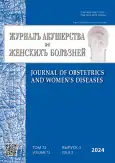ABC of the future: prolonged coculture of human embryos with endometrium in a nutrient medium in vitro
- Authors: Bespalova O.N.1, Komarova E.M.1, Lesik E.A.2, Ob’edkova K.V.3, Tapilskaya N.I.3, Kogan I.Y.1
-
Affiliations:
- The Research Institute of Obstetrics, Gynecology and Reproductology named after D.O. Ott
- The Research Institute of Obstetrics, Gynecology, and Reproductology named after D.O. Ott
- The Research Institute of Obstetrics, Gynecology and Reproductology named after D. O. Ott
- Issue: Vol 73, No 3 (2024)
- Pages: 19-25
- Section: Original study articles
- Submitted: 14.03.2024
- Accepted: 15.03.2024
- Published: 17.07.2024
- URL: https://journals.eco-vector.com/jowd/article/view/629131
- DOI: https://doi.org/10.17816/JOWD629131
- ID: 629131
Cite item
Abstract
BACKGROUND: The development of new systems for the cultivation of embryos of model objects and the creation of embryonic models based on stem cells allow for describing the events of early embryogenesis in more detail. However, these models have a number of limitations, endorsing only indirect extrapolation of the knowledge gained to events occurring in vivo. Despite certain limitations, including those related to some differences between embryos developing in vivo and in vitro, implantation conditions in vivo and in vitro, and limited time for culturing human embryos, the study of post-implantation development has great prospects.
AIM: The aim of this study was to evaluate the viability and potential for the development of human embryos from the blastocyst stage during their prolonged coculture with the endometrium in culture media designed to support the growth to the blastocyst stage.
MATERIALS AND METHODS: Embryos obtained through assisted reproductive technology were cultured from the blastocyst stage to day 19st of development in culture media designed to support the growth to the blastocyst stage, in the presence of the endometrium. On day 19st, embryos and endometrial fragments were assessed under an inverted microscope using Hoffman modulation contrast.
RESULTS: During visual assessment under an inverted microscope on day 19st of development and days 13–14st of coculture with the endometrium, viable developing embryos without signs of degradation were recorded, both freely located in a mass of undifferentiated cells and in direct contact with the endometrium.
CONCLUSIONS: The data obtained indicate the ability of the embryo to further develop in the presence of the endometrium from the blastocyst stage to day 19st in in culture media that supports the growth to the blastocyst stage. This may serve as an experimental model for both evaluating endometrial receptivity in vitro and studying intercellular communication during implantation.
Keywords
Full Text
About the authors
Olesya N. Bespalova
The Research Institute of Obstetrics, Gynecology and Reproductology named after D.O. Ott
Email: shiggerra@mail.ru
ORCID iD: 0000-0002-6542-5953
SPIN-code: 4732-8089
MD, Dr. Sci. (Med.)
Russian Federation, Saint PetersburgEvgenia M. Komarova
The Research Institute of Obstetrics, Gynecology and Reproductology named after D.O. Ott
Author for correspondence.
Email: evgmkomarova@gmail.com
ORCID iD: 0000-0002-9988-9879
SPIN-code: 1056-7821
Cand. Sci. (Biol.)
Russian Federation, Saint PetersburgElena A. Lesik
The Research Institute of Obstetrics, Gynecology, and Reproductology named after D.O. Ott
Email: lesike@yandex.ru
ORCID iD: 0000-0003-1611-6318
SPIN-code: 6102-4690
Cand. Sci. (Biol.)
Russian Federation, Saint PetersburgKsenia V. Ob’edkova
The Research Institute of Obstetrics, Gynecology and Reproductology named after D. O. Ott
Email: obedkova_ks@mail.ru
ORCID iD: 0000-0002-2056-7907
SPIN-code: 2709-2890
MD, Cand. Sci. (Med.)
Russian Federation, Saint PetersburgNatalia I. Tapilskaya
The Research Institute of Obstetrics, Gynecology and Reproductology named after D. O. Ott
Email: tapnatalia@yandex.ru
ORCID iD: 0000-0001-5309-0087
SPIN-code: 3605-0413
MD, Dr. Sci. (Med.), Professor
Russian Federation, Saint PetersburgIgor Yu. Kogan
The Research Institute of Obstetrics, Gynecology and Reproductology named after D.O. Ott
Email: ikogan@mail.ru
ORCID iD: 0000-0002-7351-6900
SPIN-code: 6572-6450
MD, Dr. Sci. (Med.), Professor, Corresponding Member of the Russian Academy of Sciences
Russian Federation, Saint PetersburgReferences
- ISSCR. Guidelines for the conduct of human embryonic stem cell research. Version 1: December 21, 2006. [Internet]. [cited 2024 Feb 12]. Available from: https://www.forth.gr/_gfx/pdf/ISSCRhESCguidelines2006.pdf
- ISSCR. Guidelines for Stem Cell Research and Clinical Translation update. Version 1.0, May 2021. [Internet]. [cited 2024 Feb 12]. Available from: https://research.wisc.edu/wp-content/uploads/sites/2/2021/10/isscr-guidelines-for-stem-cell-research-and-clinical-translation-2021.pdf
- Bespalova ON, Kogan IY, Komarova EM, et al. The experience of extended in vitro human embryo cultivation in a culture medium containing endometrium cells. A pilot study. Journal of Obstetrics and Women’s Diseases. 2022;71(4):13–20. EDN: ZMYAAQ doi: 10.17816/JOWD109215
- Gardner D, Schoolcraft W. In-vitro culture of human blastocyst. In: Jansen R, Mortimer D. editors. Towards reproductive certainty: fertility and genetics beyond. Carnforth: Parthenon Publ. 1999:378–388.
- Zhai J, Xiao Z, Wang Y, et al. Human embryonic development: from peri-implantation to gastrulation. Trends Cell Biol. 2022;32(1):18–29. doi: 10.1016/j.tcb.2021.07.008
- Koot YE, Teklenburg G, Salker MS, et al. Molecular aspects of implantation failure. Biochim Biophys Acta. 2012;1822(12):1943–1950. doi: 10.1016/j.bbadis.2012.05.017
- Sharkey AM, Macklon NS. The science of implantation emerges blinking into the light. Reprod Biomed Online. 2013;27(5):453–460. doi: 10.1016/j.rbmo.2013.08.005
- Weimar CH, Post Uiterweer ED, Teklenburg G, et al. In-vitro model systems for the study of human embryo-endometrium interactions. Reprod Biomed Online. 2013;27(5):461–476. doi: 10.1016/j.rbmo.2013.08.002
Supplementary files









